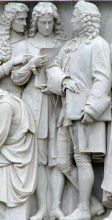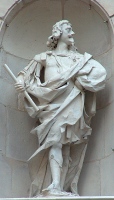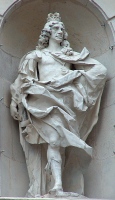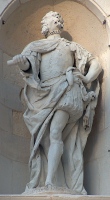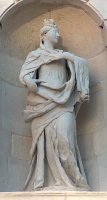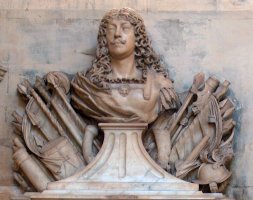John Bushnell (1636-1701)
John Bushnell (right)
The life of the sculptor John Bushnell, an artist now rather obscure, is known uncommonly well because of the various notes by Vertue on him, and most accounts of him would seem to derive from this source. In the mid-19th Century he was still much esteemed, and found a place among the pantheon on the Albert Memorial - the picture above shows him standing on the right, with Grinling Gibbons and Francis Bird. Mrs Esdaile, the most important of writers on English sculpture until Rupert Gunnis, made a particular study of Bushnell, based on the Vertue manuscript, and made her own attributions of various unsigned works to Bushnell s hand. To quote from Vertue, then:
Mr Bushnall statuary (his Father a Plummer). he born in London. put apprentice to [Thomas] Burman, a good Mason and Carver of that Time. Under him he learnt, or rather his workmen by drawing modelling and Studying, when near the end of his aprentiship (his Mistress being brought to bed) in which Time her nurse that attended her was got with child by ye Master, but he so contriv d it. that Bushnall was marryd to her, the remaining part of his Time given up. After this Bushnall was by his Master imployd. & sent to put up a Monument in the Country, part of the money [being 15 pounds] he receiv d & went off with it unknown to any one. Travell d abroad & there studied & became an Excellent Master. Was at Rome, Venice. &c. & many parts of Italy. After nine or ten years he return d home, sett up in London in Hatton Garden.
Bushnell figures for Temple Bar: Charles I and Charles II.
By 1669 Bushnell was producing commissions in England, and among his most important surviving works are the four statues, made in about 1670, for Christopher Wren s Temple Bar. These remarkable statues epitomise his style: rather than standing, they pose, even strut, one foot typically stalking forward, a hand on hip, the other arm gesturing dramatically, head poised with gaze to one side, as if too proud to stare at the spectators in front and below. The drapes are great swathes of fabric wound round the body as in Italian Renaissance paintings. Overall, the word to describe his work is flamboyant . The four statues are Charles I, Charles II on the one side, and James I, and a queen, probably Elizabeth I, on the other. In less favourable characteristics, the neck is typically long, the legs disturbing in their proportions and anatomy around the knees. This weakness at anatomy plagued him during his own lifetime. As reported by Vertue:
Some of the Carvers had reported he could not make a naked statue. Tho he coud plant a figure well. & do the heads hands & feet with a piece of drapery very well as they allow. Yet that was much inferior to a Naked statue, which he was not Capable of doing. This piqu d him so, he immediately & privately sett about a Statue of Alexander the great with a scroll in his hand. [in margin: as I have since seen this Statue, it appears to me to be a near imitation of a Natural body. Inclin d to Stiffness. Wanting grace.] (still in being at his own ruinated house.) where you may see the beautifullst body and limbs possible to be immagin d. the head the most wretched to the neck. The hands ill form d. the feet crippel d. as bad as possible coud be while the other parts extreamly well.
While it is hard to disagree with the lesser quality of some of the parts, the flair and elan of the poise give Bushnell s figures something of greatness, and it is a pleasure to come across his works.
Bushnell figures for Temple Bar: James I and a Queen, perhaps Elizabeth I.
In London, we may see another grand example of his work in All Saints Church, Fulham, which is the similarly flamboyant figure of John Mordaunt, d.1675 (see picture below: please ask the Church if wishing to reuse this image - more on this monument on this page). And in the City Church of St Olave s Hart Street may be seen the monument to Mrs Pepys, d.1669, wife of the great diarist, showing a fine bust in a niche, and below, a cartouche with an extravaganza of deep-cut swirls, flowers, a cherubic head, and two skulls. To my mind, this is Bushnell s best surviving female portrait. In St Olave s too is a standing figure of Sir Andrew Riccard, d.1672, which Mrs Esdaile ascribes to Bushnell. The attribution is plausible, but slightly uneasy in that the pose is less good than his other male figures but if not Bushnell, it is hard to guess who could have been the sculptor, so I would tend to bow to her expertise.
Lord Mordaunt, in All Saints Church, Fulham.
Bushnell has work in Westminster Abbey (Isaac Barrow), and three figures which he made for the old Royal Exchange Gresham, Charles I and Charles II now stand in the Central Criminal Court, Old Bailey. All these are flamboyantly posed and dressed, with sweeping gestures, masses of drapery over their bodies, and a look of self conscious superiority and self regard.
Outside of London, Bushnell has several monuments in churches, and in the city of Bath, where his monument to Sir Philip Frowde is in Bath Abbey a bust of an especially haughty man, with ringletted hair and a moustache, with to the sides, a trophy of various weapons, and the panel below as if on a shroud, finely cut.
Frowde monument, Bath Abbey.
Many other of Bushnell s sculptural works do not survive, and of his paintings for he painted also none are known to have come down to the present day. One vanished work should be mentioned in response to some comment about the impossibility of the famous Horse of Troy, Bushnell made a giant wooden statue of the horse, covered in stucco, where, the head of this horse, it was so big, that it wou d contain easily twelve men to sitt round a Table. & the two Eyes serv d for windows . Alas, a gust of wind blew the thing down and broke it.
Bushnell became very well off, and built a house for himself alongside Hyde Park. However, his quarrelsome, self-regarding nature, where he felt himself to be slighted and not given his due by an ungrateful public, led to him becoming somewhat reclusive, and not of sound mind. After his death, in his crumbling mansion lived two of his sons, with the remains of his unsold work, which according to different notes in the Vertue notebooks, they either tried to preserve, or wantonly destroyed:
He built that house near high park but did not finish it where still lives two sons of his like Hermitts or Brutes, because they converse with no man nor are sociable creatures, have nothing in them, but say the world is unworthy of their fathers works, so won t let them be seen, & carelessly and malitiously destroy them daily. Into heaps of shater d heads, arms, legs &c.
Bushnell died in 1701, and buried in the grounds of St Mary Paddington Green, but no trace of any monument survives.
